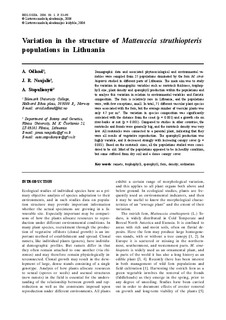Variation in the structure of Matteuccia struthiopteris populations in Lithuania
Journal article, Peer reviewed
Published version
Permanent lenke
http://hdl.handle.net/11250/2437952Utgivelsesdato
2006Metadata
Vis full innførselSamlinger
Originalversjon
Odland, A., J. Naujalis, and A. Stapulionyte. 2006. Variation in the structure of Matteuccia struthiopteris populations in Lithuania. Biologija 1:83-90.Sammendrag
Demographic data and associated phytosociological and environmental variables were sampled from 25 populations dominated by the fern M. struthiopteris studied in different parts of Lithuania. The main aim was to study the variation in demographic variables such as rootstock thickness, trophophyll size, plant density and sporophyll production within the populations and to analyse this variation in relation to environmental variables and floristic composition. The fern is relatively rare in Lithuania, and the populations were, with few exceptions, small. In total, 71 different vascular plant species were associated with the fern, but the average number of vascular plants was only 4.7 per m??. The variation in species composition was significantly correlated with the distance from the coast (p = 0.001) and a growth site on river-banks or not (p = 0.001). Compared to studies in other countries, the rootstocks and fronds were generally big, and the rootstock density was very low. All rootstocks were connected to a parental plant, indicating that they were all results of vegetative reproduction. The sporophyll production was highly variable, and it decreased strongly with increasing canopy cover (p = 0.001). Based on the rootstock sizes, all the populations studied were considered to be old. Most of the populations appeared to be in healthy condition, but some suffered from dry soil and a dense canopy cover.
Opphavsrett
© Lietuvos mokslų akademija, 2006© Lietuvos mokslų akademijos leidykla, 2006
